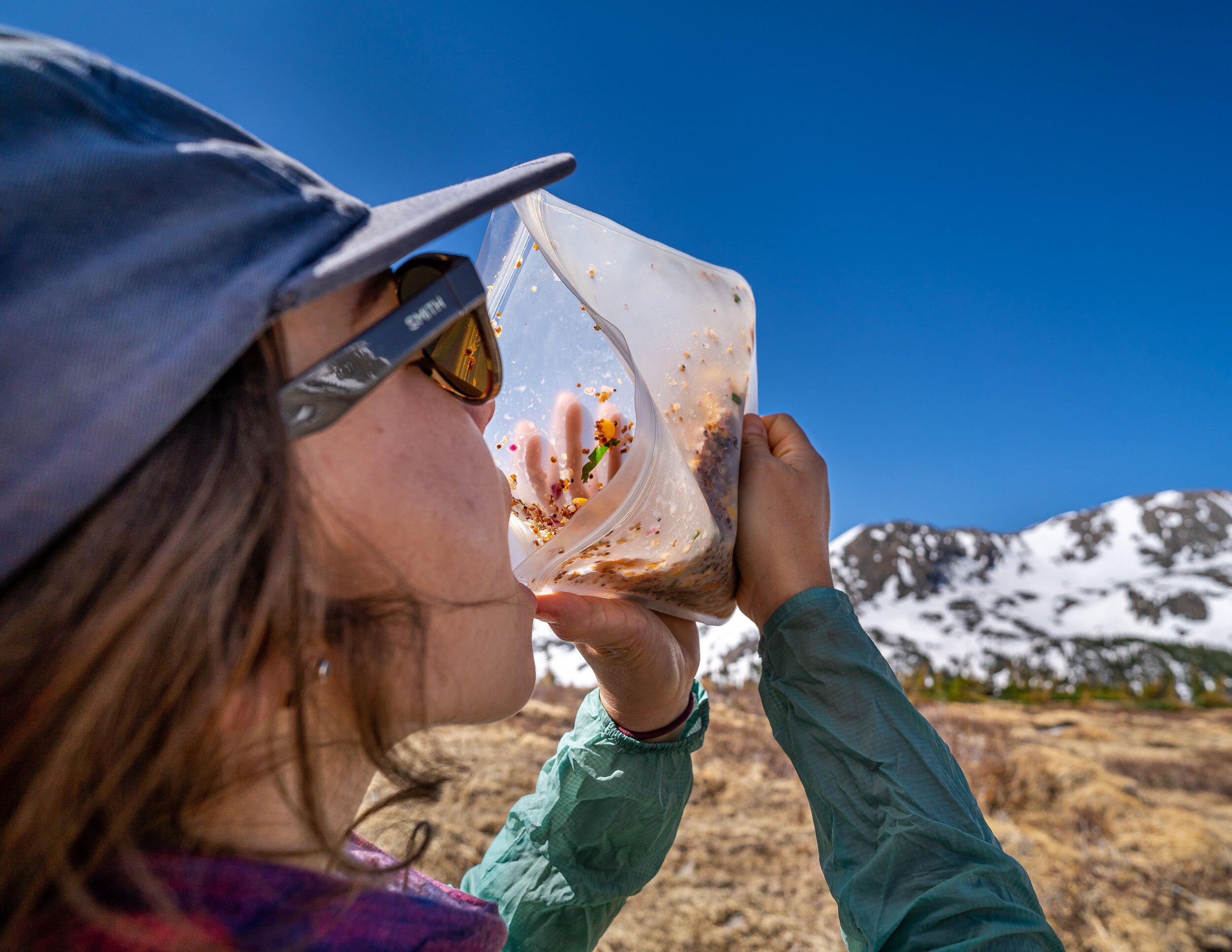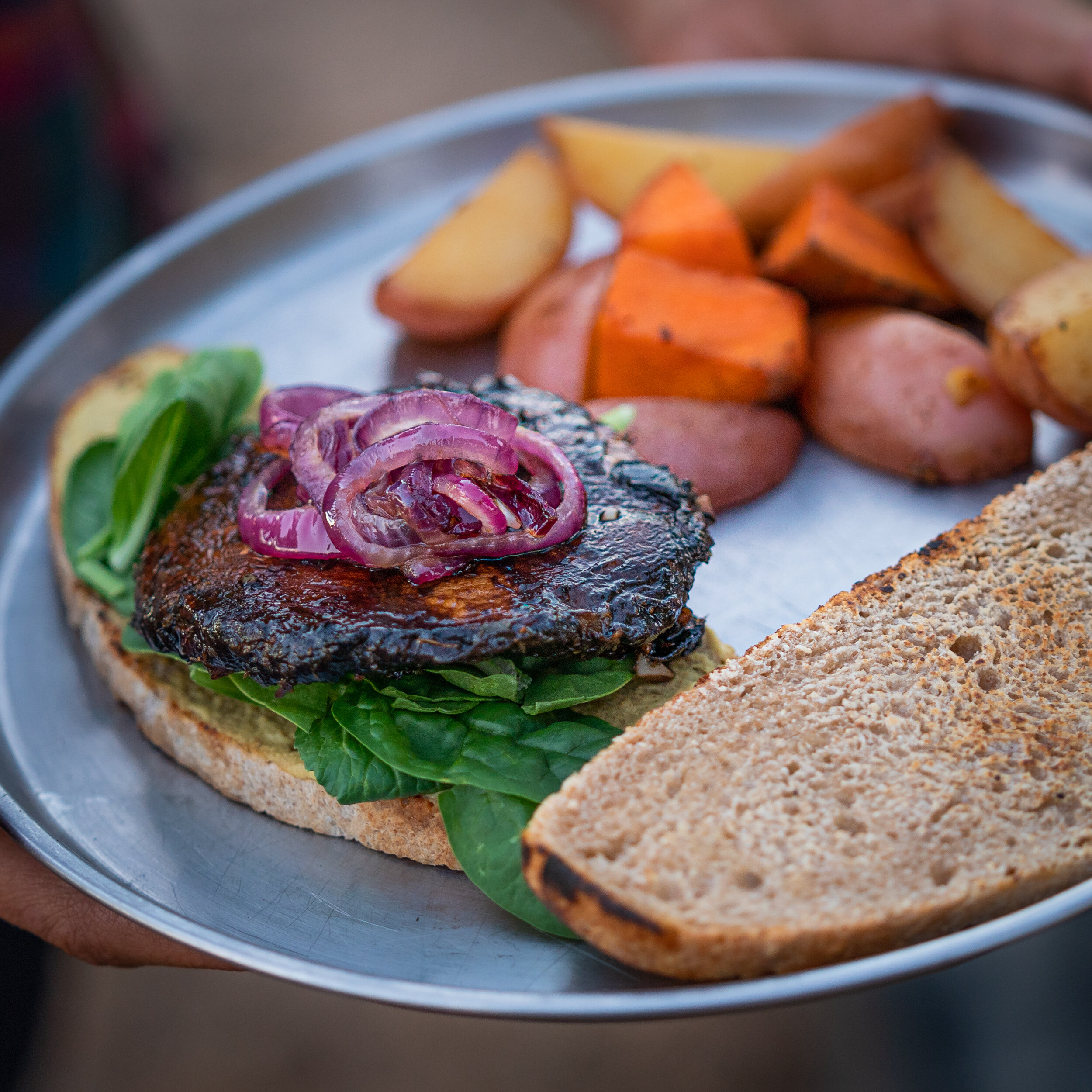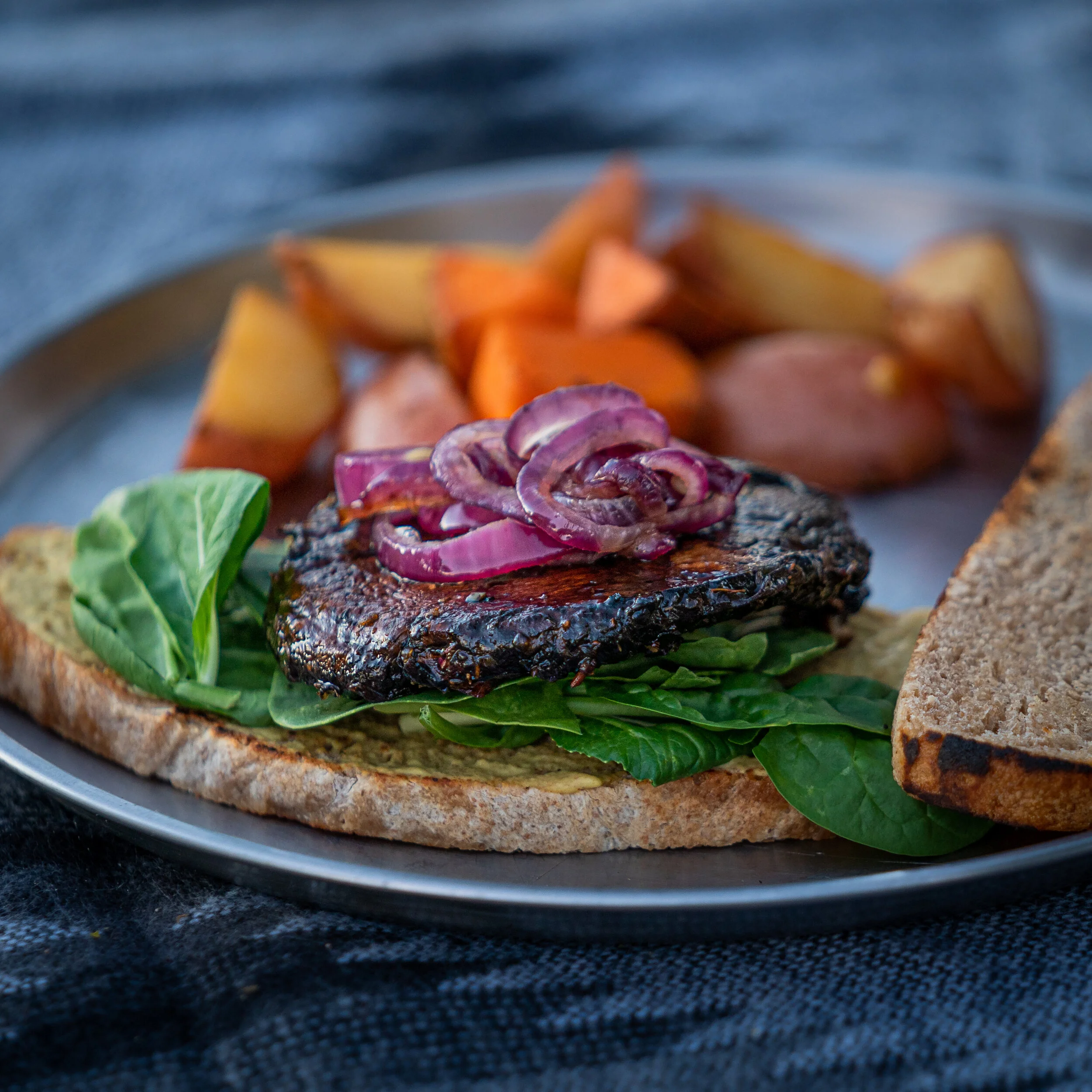
PLANT-BASED Camping recipes CRAFTED FOR ADVENTURE.
Grit-ty
1.) Being covered with dirt, sand, etc. The feeling that comes after an epic day of hugging rocks, playing in the sand, or pounding your feet across miles of trail. Often accompanied by the type of hairstyle that would have your mother send you directly to the shower if she saw you.
2.) Showing courage, determination, and quick thinking in the face of adversity. Having the adaptability to manage any situation and make the best of the cards you’ve been played.
Gour-met
1.) Fancy, delicious, sometimes over the top. Warm spices that you tuck into a pocket of your backpack to pull out at just the right time on a cold night. A bottle of actually nice wine at basecamp. The kind of thing that makes you ask, “is it worth it?” and it always is.
2.) That magic touch that turns something from good to great.
Grit-ty Gour-MEt
1.) A style of outdoor cooking that is delicious and functional at the same time. Creative, simple, and wholesome plant-based camping recipes for people on the road, in the mountains, and on the wall. Real plant based camping recipes for real adventures.
2.) The person everyone at camp wants to be friends with. They whip up pizza from scratch after a day in the alpine and roll out empanada dough on crash pads. Their hands are dirtier than you’d like but their food takes your taste buds away on a heavenly dream, even when you’re stuck fitting three friends in your tiny 2-person tent, days from the nearest bathtub.
Eating outdoors doesn’t mean you have to settle.
As outdoor adventurers, we know everything get’s a little better when we spend time outside. Our problems get a little smaller, the views get a little sweeter, and the people get a little weirder. So why are you settling for mediocre trail snacks, processed backcountry meals, and camping recipes that don’t really work for the activities you take them on? Whether you’re a climber, hiker, biker, or underwater basket weaver, you’ve likely come to realize that what you eat effects how you feel- everyday, and especially when you’re out on your favorite adventure.
That’s why Gritty Gourmet came to be.
Here, we know that food is an integral part of our health. We value the time spent around a campfire, cooking up something to share with friends after a long day out climbing. And we also know when it’s time to throw something in our backpacks that can fuel us for long hours out hiking (and reward us just as much as the view at the summit when it’s time to eat). Life in the outdoors is unpredictable, so the plant-based camping recipes we make have to be adaptable. But, with a little planning and creativity, simple, whole foods can make nourishing and delicious meals- no matter the conditions. That’s why these plant-based camping, hiking, and climbing recipes are crafted for adventure.

The Gritty Gourmet Philosophy
I grew up with a mother that cooked gourmet, healthy, and insanely delicious food every day, and with a dad that would bring bean burritos from Taco Bell as his only sustenance if it meant he could get to the Grand Canyon and start backpacking sooner. The philosophy behind Gritty Gourmet falls somewhere in between there.
FOOD IS FUEL,
What you eat directly translates towards how you feel and what your body can handle. As a climber (among other ways I enjoy the outdoors), I put my body through a lot- and chances are, if you’re reading this, you do to. Eating healthy and nutritious food is a necessity if we want to keep our bodies fueled for the adventure we love. And having the right plant-based camping recipes makes that a lot easier.
SO CHOOSE THE GOOD STUFF.
Eating well doesn’t have to be complicated, and it sure can taste good. While we’re at it, let’s make sure that the ‘good stuff’ we eat is good for the environment we live and play in, too. That means searching for more sustainable food options that have a lower footprint, less packaging, and travel less to get to your shopping cart. Many options for outdoor camping and backpacking meals are processed, packaged, and shipped long distances, but it’s not the only way to plan what you’re going to eat on your next camping or backpacking trip. With a little thought and effort, you can make healthy and sustainable plant-based camping recipes that fit your busy days out on the trail or the wall.
AND THEN ADVENTURE ON…
Like my dad, I’d do just about anything to get a few more hours outside, so Gritty Gourmet recipes are designed to fit the time, energy, and resources you’ll have on hand for the many circumstances that come with adventure. A gourmet plant based camping recipe might look amazing online, but it doesn’t pass the test unless I can climb hard all day, get to camp late, and still want to make it. Life outdoors, whether climbing, camping, hiking, or anything, is unpredictable at best, so good outdoor camping recipes have to be up for the challenge. That means the recipes we love have to be adaptable and crafted for adventure.

Featured FAll camping Recipe
PORTOBELLO BUGERS MARINATED WITH GARLIC AND BALSAMIC VINEGAR
Fall is just around the corner, but we’ve still got a few more weeks (or a month, depending on where you live) of glorious time spent outside before it really becomes a struggle to stay out of your sleeping bag past 7:00 pm. As the temps begin to change and nightfall gets a little colder, eating something tasty starts to become a lot less important to our cold, cold fingers, but our stomachs still rumble after a long days adventure. Even if it’s less fun in the cold, fueling your body properly after a day hiking or climbing is the key to success. Getting proper nutrition from your camping recipes is even more important as the weather gets colder. When temps start dropping, your body has to put in more work-just to keep your body regulated and warm throughout the day. That means more calories are being burned than usual, and more reasons why you need a quick, tasty fall camping recipe.
Enter the glories of marination. If you’ve never done it, here’s the deal: you throw a bunch of stuff in a bag, let it sit for a while, and then cook it. And it makes everything taste good. The end.
This marinated portobello burger camping recipe is a favorite of mine for fall camping because most of the work can be done hours or a day ahead of time, and it still offers the fulfillment you crave, especially after a colder day spent outside. The marinade for this portobello burger recipe is simple and only uses things you’ll usually already have on hand when you’re packing for a trip. Bonus: if you really want to save time and energy on meal time, you can mix together all the ingredients for this portobello burger marinade before you leave the house. Less dishes, less room, less time. Booyaaa.
Using a reusable bag such as my personal favorites made from Stasherbag makes this camping recipe free of single-use plastic, and lot more eco-friendly than a freeze dried meal. It’ll also eliminate the issue of marinade spillage that tends to happen with regular throw away plastic bags.
Additionally, this plant-based portobello burger camping recipe offers a lot of variety when it comes to what type of meal you want. Did you just finish up a long day of multi-pitching or getting whipped crack climbing in Indian Creek? Refuel by serving on a whole wheat bun with some roasted potatoes. Trying to keep it light because you’ve been drinking more crag sodas than actually climbing? Opt to enjoy this camping portobello burger over some greens.
Like I’ve mentioned before, one of the elements that makes healthy, sustainable outdoor cooking possible is thinking ahead. If you’re out on a trip, be it for the weekend or a month, chances are you won’t want to be making a new camping recipe every day, so it’s important for recipes to have diverse uses, making it possible to cook one time and use the leftovers for breakfast or lunch the next day. With that in mind, here’s a few suggestions for using this portobello burger camping recipe the day after:
Breakfast veggie scramble: crack a few eggs, add some onions and peppers along with diced portobello burger, and enjoy a quick plant-based camping breakfast.
Hummus wraps: Up your tortilla game by adding some slices of portobello burger, a spoon of hummus, and some spinach or kale.
Balsamic quinoa salad: Get lunch ready at the same time you cook dinner. Fill a reusable bag with cooked quinoa, diced portobello, feta cheese, and some kalamata olives for a high protein lunch that’s ready to go in the morning.
PORTOBELLO BURGERS MARINATED WITH GARLIC AND BALSAMIC VINEGAR
1/8th cup balsamic vinegar
3 tablespoons olive oil
3 cloves garlic, diced
1 tablespoon oregano
2 portobello mushroom heads, cleaned
salt and pepper to taste
Place all ingredients inside a reusable plastic bag and seal tightly. Shake for 15 seconds to mix marinate and fully coat mushrooms, then let marinate for at least 15 minutes (up to 2 hours). When ready to cook, bring a pan to medium high heat and place entire contents of bag in the pan. Cook for 3-6 minutes on each side, then serve as desired.
Recipe serves 2.

from the Blog…
How To crush Cold Weather Camping Like A Pro
1. CHECK THE WEATHER AND PLAN ACCORDINGLY
This might seem like a no brainer when it comes to fall camping, but it’s got to be said. We all want to get out and enjoy the glories of fall, but if the forecast is miserable, it might be best to save your camping trip for another weekend. If there’s one day that looks particularly cold or wet, plan your camp cooking recipes accordingly. Be realistic here. You know you won’t be excited to stand out by a cookstove for an hour if it’s 40 degrees or drizzling on you. If that’s what the forecast is calling for, plan a quick meal that you can prepare in a few minutes, or better yet, cook something extra the day before that you can reheat.
4. BE WARY OF THINGS THAT FREEZE
And things that thicken or congeal when it gets cold. First off, if you’re going fall camping when it’s gonna drop below freezing at night, bring some water with you in your tent at night so you have some for your morning coffee. Keep your water container in your car too- it’s not a given that that’ll keep it from freezing but it’s a better bet than leaving things outside. Besides the obvious liquids, be smart about what kind of cooking oil you’re using. As a rule of thumb I usually only use coconut oil for my go-to camp cooking oil, but this is really important for cold weather camp cooking. Here’s why. That cute olive oil bottle? Not so cute when your oil is frozen inside your bottle and you can’t pour any out to cook your eggs in the morning. Coconut oil comes in a jar, so you can scrape out what you need with a spoon. Even when it’s frozen.
2. PLAN AND PREP YOUR FOOD AHEAD OF TIME
After seeing what Mother Nature has in store for your fall camping time, make a meal plan for your trip. This doesn’t have to be anything crazy, but have an idea of what you’re making for each meal. The most helpful reason to make a meal plan for your fall camping trip is: leftovers. Yum. It’s such a mystery to me why people don’t think about this more often when they’re camp cooking, but leftovers and shared ingredients between recipes are key. This saves you time and energy, and for colder weather, those are two things you’ll be wanting to preserve. If you’re going out for multiple days, plan the same lunch for two days and make it in bulk the first day. Using chickpeas for dinner? Make extra and use them for a breakfast scramble the next day.
I always suggest prepping food ahead of time if you can, but this is especially helpful for fall camp cooking. If you’re headed out for a fall camping weekend trip, it’s possible to have pretty much everything “done” before you head out. To cut down on the amount of time you need to spend cooking out in the cold, pre-cook all those items that take more time- quinoa, rice, beans, potatoes. This little bit of extra prep time means that dinner only takes as long as you need to roast up some veggies or chop up whatever you’re serving your main protein/carbs with.
3. BRING EXTRA FUEL AND A LID
If you’re used to camp cooking in warm weather, you’ll be surprised by how much more fuel you’ll burn cooking in colder temps. Even for simple tasks like boiling water, lower temps really do affect the fuel efficiency of your camp cooking stove- regardless if its a whisperlite or a classic two-burner. You’ll notice the same thing happening if you’re trying to cook in a windy place. Not only is it a total pain to try and light your stove, things don’t cook as quickly. To combat the cold weather effects on your camp cooking, remember to pack a lid for your pots and pans- preferably one that actually fits. Trying to cook in the cold without a lid is a total pain in the ass. As someone who’s forgotten to pack this simple (and very overlooked item) many times on a fall camping trip, trust me here. If you’re cooking something that requires two pots or pans...you guessed it! Bring two lids.
5.) GIVE YOUR BODY WHAT IT NEEDS
Your body has to work extra hard to regulate itself when it’s in colder temperatures, so make sure you’re giving yourself the nutrients and calories you need on your fall camping trip. This is super important if you’re exerting yourself- hiking, climbing, biking, etc. You may notice that your appetite seems to increase as the weather gets colder, and that’s natural. Eating makes your body warmer and gives it more energy, so it’s normal to be more hungry in colder weather. This isn’t to say that we should just lay around and eat all day (although some days that does sound pretty cool), but keep in mind that your fall camping trip might not be the best time for a juice cleanse. There are plenty of ways to keep your body happy with healthy plant-based meals- so listen to your body and make sure you’re fueling up with good camp cooking meals. This goes for hydration too! You might not notice yourself getting as thirsty as you do in the heat of summer, but proper hydration is always a necessity. Track your water intake throughout the day with your favorite reusable water bottle and be aware of dehydration symptoms like a headache.






